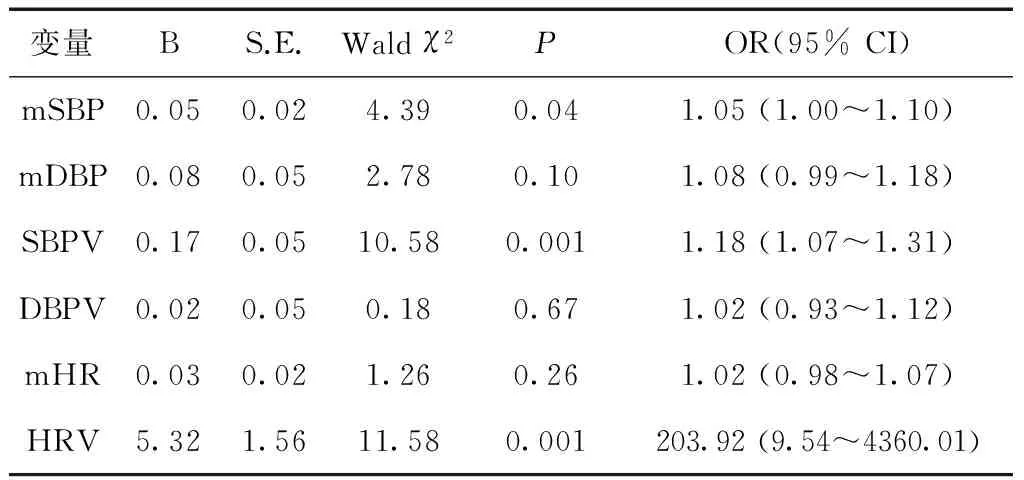高血压患者认知功能障碍与动态血压的关系及其危险因素分析
2017-09-13朱朝江赵大威
朱朝江,张 彬,赵大威
(1.重庆市九龙坡区第二人民医院心血管内科,重庆 400052;2.第三军医大学附属大坪医院超声科,重庆 400042)
高血压患者认知功能障碍与动态血压的关系及其危险因素分析
朱朝江1,张 彬1,赵大威2
(1.重庆市九龙坡区第二人民医院心血管内科,重庆 400052;2.第三军医大学附属大坪医院超声科,重庆 400042)
目的探讨高血压患者动态血压变化与认知功能的关系及其危险因素。方法收集2015年6月至2016年6月我院心内科61例高血压患者,按照简易精神状态检查量表(Mini mental state examination, MMSE)评分分为认知功能障碍组(试验组)32例和认知功能正常组(对照组)29例,对比两组24 h动态血压指标并进行Logistic回归分析。结果试验组MMSE评分明显低于对照组,差异有统计学意义(P= 0.0001)。试验组mSBP、SBPV和HRV明显高于对照组。两组mDBP、DBPV及mHR比较,差异无统计学意义(P均>0.05)。回归分析结果显示:mSBP(OR=1.05,P= 0.04)、SBPV(OR=1.08,P= 0.001)和HRV(OR=203.92,P= 0.001)是认知功能障碍的危险因素。结论mSBP、SBPV和HRV是发生认知功能障碍的危险因素。
动态血压;认知功能;危险评估
高血压由于收缩压(systolic blood pressure, SBP)升高可以引起认知功能障碍,其机制与收缩压升高引起脑血管内皮功能障碍、微栓子、氧化应激及脑动脉粥样硬化有关[1]。高血压患者的血压变异(blood pressure variation,BPV)与颈总动脉内膜中层厚度(carotid intima-media thickness,cIMT)具有相关性,提示BPV与中风和认知功能下降有关[2]。另外,研究发现静息心率(Heart rate,HR)升高在高血压患者中影响心血管疾病的预后[3],例如导致冠状动脉疾病、心脏衰竭、诱导内皮功能障碍[4],以及在脑梗死增大梗死体积[5]。目前,高血压患者相关临床指标(SBP、BPV、HR)等与认知功能之间的关系研究较少,尤其是这些因素对认知功能的影响及危险评估还未见相关报道。本研究通过分析高血压患者SBP、BPV以及HR等指标与认知功能之间的关系,找出可能影响认知功能的危险因素,从而为防治高血压引起认知功能障碍提供临床依据。
1 资料与方法
1.1一般资料按照2010年《中国高血压防治指南》[6]中的高血压诊断标准,选取2015年6月至2016年6月我院心内科收治的高血压患者61例,其中男43例,女18例,年龄(56±11.6)岁。所有入选患者均未停服抗高血压药物。排除合并代谢性疾病、瓣膜性疾病、心力衰竭、短暂性脑缺血发作史、脑卒中患者。通过MMSE评分[7],将患者分成了两组:试验组为存在认知障碍组(32例);对照组为无认知障碍组(29例)。试验组患者的MMSE评分[(20.52±2.52)分]明显低于对照组患者的评分[(26.91±3.29)分],差异有统计学意义(P= 0.0001)。两组患者的一般资料,包括年龄、BMI、性别比例、高血压病史以及受教育程度等基本因素差异无统计学意义(均P> 0.05),见表1。本研究已经由我院伦理委员会批准,充分告知取得患者同意并签署知情同意书。

表1 两组患者一般资料比较
1.2动态血压监测采用欧姆龙HEM757无创便携动态血压监测仪(日本欧姆龙公司)检测动态血压,将袖带绑在左上臂调定时间,设定日间6时至22时每30分钟测量1次,夜间22时至次日6时每1小时测量1次,记录大于24小时的血压值,测量次数超过80%者为有效。血压和HR的变异用变异系数(coefficient of variation, CV)来表示,即标准差和平均值的百分比。计算24小时的平均收缩压(mean systolic blood pressure, mSBP)、平均舒张压(mean diastolic blood pressure, mDBP)、收缩压变异(systolic blood pressure variation, SBPV)、舒张压变异(diastolic blood pressure variation, DBPV)、平均心率(Mean heart rate, mHR)、心率变异性(Heart rate variation, HRV)。
1.3统计学方法采用SPSS 17.0软件进行统计分析。计量资料以均数±标准差描述,组间对比采用非配对双尾t检验进行分析;计数数据采用χ2检验,危险因素对自变量进行Logistic单因素分析。P< 0.05为差异有统计学意义。
2 结果
2.1两组患者动态血压指标的差异试验组患者的mSBP、SBPV和HRV明显高于对照组,差异有统计学意义(P< 0.05)。而两组mDBP、DBPV和mHR比较,差异无统计学意义(均P> 0.05),见表2。

表2 两组患者动态血压参数比较
2.2动态血压指标与认知功能的关系回归分析分析结果显示,mSBP、SBPV和HRV是认知功能下降的危险因素,见表3。

表3 血压患者认知功能下降危险因素的Logistic回归分析
3 讨论
随着我国生活水平的提高以及人口老龄化的发展,高血压在人群中的发病率越来越高,高血压引起的认知功能障碍人数也在不断的增加,导致人口老龄化痴呆的发病率增加。研究表明,在高血压患者中,BPV与高血压靶器官损害、靶器官损害进展和心血管病死率成正相关,不论血压水平如何,BPV越大,高血压靶器官损害越严重,高血压患者的BPV与cIMT增厚呈正相关,且BPV独立于血压水平[8]。这些都表明高血压患者中BPV水平与靶器官损害有密切的关系,并可以作为危险因子对其进行预测。
研究表明,高血压也是脑血管病的一个重要危险因素,对认知功能障碍的发生发展也起一定的作用。BPV升高可以使脑血管结构的改变导致动脉硬化的持续发展,微小动脉发生玻璃样变,动脉变细或闭塞导致该血管供血的脑区发生缺血或缺血性梗死[9]。另外,BPV升高可严重损害脑血流的稳定性,使得脑血流的自动调节和侧枝循环受损,导致脑血流量减少以至于脑组织受损[10]。海马是记忆环路的主要部分,对缺氧缺血十分敏感,因此高血压患者常常具有记忆功能受损的表现。Nagai对未治疗的老年高血压患者分析动态血压、颅脑磁共振、MMSE量表等,发现认知障碍和脑萎缩的重要危险因素是24小时动态血压中SBP及夜间SBP非勺型改变,对其干预可以有效预防患者出现认知功能障碍和脑萎缩现象[11]。平稳的血压控制能够改善血压变异性,降低SBP晨峰水平,血压波动小,保持充足的脑灌注,保护认知功能。
本研究发现,MMSE评分判断≤24分的认知功能障碍患者中,mSBP、 SBPV和HRV均高于对照组。mSBP、SBPV和HRV是认知功能下降的独立危险因素。平均血压和认知功能障碍有关,SBP 的变化被证明可以预测高血压患者卒中发生率以及死亡率,并与患者的微出血和缺血性卒中后白质病变有关。高血压患者HR降低对动脉粥样硬化斑块形成很强的负相关,促进侧枝生长,保护血管内皮功能,防止血管功能障碍。HRV显示出对认知功能障碍有较大的影响。
综上所述,mSBP、SBPV和HRV水平与认知功能障碍受损有明显的相关性。高血压患者认知功能障碍,mSBP水平、SBPV和HRV水平可能在这些高血压患者被认为是认知功能障碍的危险因素,可能是重要的判断未来的认知功能障碍的危险因子。
[1] Joas E, Bckman K, Gustafson D, et al.Blood pressure trajectoriesfrom midlife to late life in relation to dementia in women followed for 37 years[J].Hypertension, 2012,59(4):796-801.
[2] Pringle E, Phillips C, Thijs L, et al.Systolic blood pressure variability as a risk factor for stroke and cardiovascular mortality in theelderly hypertensive population[J].J Hypertens, 2003,21(12):2251-2257.
[3] Kolloch R, Legler UF, Champion A, et al.Impact of resting heart rate on outcomes in hypertensive patients with coronary artery disease:findings from theINternational VErapamil-SR/trandolapril STudy (INVEST)[J].Eur Heart J, 2008,29(10):1327-1334.
[4] Bhm M, Swedberg K, Komajda M, et al.Heart rate as a risk factor in chronic heart failure (SHIFT):the association between heart rate and outcomes in arandomised placebo-controlled trial[J].Lancet, 2010,376(9744):886-894.
[5] Custodis F, Gertz K, Balkaya M, P et al.Heart Rate Contributes to the Vascular Effects of Chronic Mental Stress Effects on EndothelialFunction and Ischemic Brain Injury in Mice[J].Stroke, 2011, 42(6):1742-1749.
[6] 中国高血压防治指南修订委员会, 中国高血压防治指南2010[J].中华心血管病杂志, 2011,39(7):579-616.
[7] Arevalo-Rodriguez I, Smailagic N, Ciapponi A, et al.Mini-Mental State Examination (MMSE) for the detection of Alzheimer’s disease and other dementias in people with mild cognitive impairment (MCI)[J].Cochrane Database Syst Rev,2015,3(3) :CD010783.
[8] Böhm M, Schumacher H, Leong D, et al.Systolic blood pressure variation and mean heart rate is associated with cognitive dysfunction in patientswith high cardiovascular risk[J].Hypertension, 2015,65(3):651-661.
[9] Ye F, Yu NW, Wu WB, et al.Impact of awake blood pressure variability on cerebrovascularatherosclerosis in Chinese patients with acute ischemic stroke[J].Blood Press Monit, 2016, 21(5):271-276.
[10]Kokubo M, Shimizu A, Mitsui T, et al.Impact ofnight-time blood pressure on cerebral white matter hyperintensity in elderly hypertensive patients[J].Geriatr Gerontol Int, 2015,15 Suppl 1(Supplement S1):59-65.
[11]Nagai M, Hoshide S, Ishikawa J, et al.Visit-to-visit blood pressure variations:newindependent determinants for cognitive function in the elderly at high risk of cardiovascular disease[J].J Hypertens, 2012,30(8):1556-1563.
Relationshipbetweenambulatorybloodpressureandcognitivedysfunctionandriskfactoranalysisinthepatientswithhypertension
ZHUChao-Jiang1,ZHANGBin1,ZHAODa-wei2
(1.DepartmentofCardiology,JiulongpoDistrictSecondPeople’sHospital,Chongqing400052,China;2.DepartmentofUltrasound,DapingHospital,TheThirdMilitaryMedicalUniversity,Chongqing400042,China)
ZHANGBin
ObjectiveTo investigate the relationship between ambulatory blood pressure and cognitive dysfunction and the risk factors in the patients with hypertension.MethodsSixty-one hypertension patients admitted to our department from June 2015 to June 2016 were divided into cognitive dysfunction group (experimental group,n= 32) and normal cognitive function group (control group,n= 29) according to Mini mental state examination (MMSE).24 hours ambulatory blood pressures of all patients were observed, and the risk factors were identified by Logistic Regression Analysis.ResultsMMSE score in the experimental group was significantly lower than that in the control group (P= 0.0001).The mSBP, SBPV and HRV in the experimental group were significantly higher than those in the control group.However, there was no significant difference in mDBP, DBPV and mHR between the two groups (AllP> 0.05).Logistic regression analysis showed that mSBP (OR =1.05,P= 0.04), SBPV (OR = 1.08,P= 0.001) and HRV (OR = 203.92,P= 0.001) were the risk factors of cognitive impairment.ConclusionThe mSBP, SBPV and HRV were risk factors associated with cognitive dysfunction in patients with hypertension.
Ambulatory blood pressure;Cognitive function;Risk evaluation
张 彬
R544.1
A
1672-6170(2017)05-0187-03
2017-03-07;
2017-07-30)
